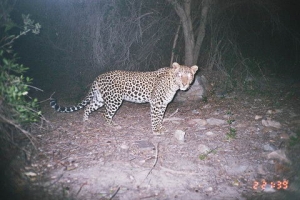There are, in truth, only a few hellish things about The Hell (or Gamkaskloof, to use the more politically correct name for the place). While some may consider the total absence of any form of communication with the outside world other than the phone line in the Conservation Manager’s office to be a problem, this is quite possibly the greatest asset of the place as well. Once one crests the Swartberg Pass at ‘Die Top’ and turns westward at the infamous, ‘Gamkaskloof 37km, travelling time 2 hours’, sign, one is cut off from the outside world. Glorious isolation awaits.
This brings me to the first Hellish part of the trip, the road. Contrary to popular belief, the road to the Hell is not paved with good intentions (in fact, it’s not paved at all). Not that it is all that bad (in fact, it’s in relatively decent shape at present), but when you pick up a puncture after about 20km, demons in the form of sharp-edged rocks and treacherous acacia thorns seem to lurk around every corner. Not a great start to the trip, given that we still had another 17km to go to reach the Hell to begin four days of fieldwork, during which we would be heavily reliant on our vehicle. Undaunted, we put our faith in Bridgestone, the Almighty and extremely cautious driving and eventually arrived in Gamkaskloof mid afternoon.
We had ventured into Gamkaskloof to initiate the final stage of the camera trap survey that has been running since March 2011, with support from the WWF Green Trust, the University of Cape Town, Rhodes University and the International Foundation for Science. The Swartberg forms the northern edge of the survey area, which extends close to the northern slopes of the Langeberg and Outeniqua Mountains. Having deliberately excluded Gamkaskloof from the survey thus far due to the logistical difficulties implicit in working in the area, our plan was to make up for lost time by setting up cameras at 12 different sites across approximately 300 km2 of pristine mountain habitat.
Our first priority was to replace the old film cameras that were originally set up in the area in 2007. An invaluable tool in the early days of Cape Leopard Trust research, the availability of digital camera traps has swiftly rendered the film models obsolete, and it was a relief to finally bring digital camera trap technology to Gamkaskloof!
Over the next couple of days the Cape Leopard Trust vehicle would become a familiar sight around Gamkaskloof, as we set up cameras from Boplaas (private land in the eastern end of the Kloof) to Elandspad in the west. The abundance of leopard signs, especially scats, made selecting sites relatively easy, and the stunning scenery made even the most arduous of hikes a pleasure. Gamkaskloof is one of those few remaining special places where wildlife has been allowed to flourish with minimal human interference, and fortunate indeed are those such as we who are able to spend time there while working!
To paraphrase Hunter S. Thompson, Gamkaskloof is a “classic affirmation of everything right, true and decent in the national character; a salute to the fantastic possibilities of life in this country, but only for those with true grit”. Gazing down the sheer cliffs that border the valley on all sides, one can not help but marvel at the spirit of the early trekkers who somehow manoeuvred their wagons down into the valley and forged a community there. The superb Donkey Trail offers one the opportunity to follow in the footsteps of that community by hiking the historical trading route over the mountain, and is certainly the ideal means of visiting Gamkaskloof for the first time.
Today, the vast majority of Gamkaskloof is owned by CapeNature, and has returned to what one imagines is somewhere close to its original state. The camera traps that we have set up in the Kloof should provide us with new insights into the wildlife of one of the truly special wild places in South Africa. We will be checking the cameras in June, and look forward to sharing the results with you!

















